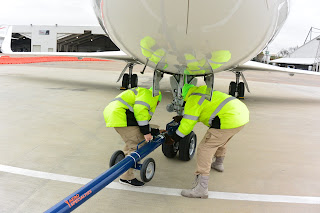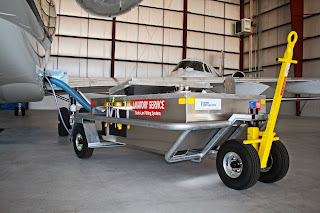The Most Common Ground Crew Accidents and How to Avoid Them
The work environment for an airport’s ground crew is a particularly
high-risk one. In fact, if one were to list major workplace risk
factors, it might harder to find the ones that don’t apply to an airport
ground crew than the ones that do.
Ground crew work often requires high-speed and high-stress tasks, such as hurrying to get aircraft ready for flight or seen to after a flight, while other aircraft are waiting for service. It also involves the use of heavy equipment and vehicles like aircraft tugs, as well as working on far larger and heavier equipment and vehicles, like aircraft. The ground crew are often carrying heavy luggage and other equipment and transporting and using any number of chemicals, including fuels, lavatory fluids, deicing fluid, and more. Not to mention the additional stress or that for many of the crew, not doing their job or doing it incorrectly can put the lives of a lot of other people in danger.
That level of risk is, of course, responsible for the significant level of regulation ground crews are familiar with. Unfortunately, those regulations don’t prevent all injuries. They can be overlooked, and attempts to cut corners that seem convenient at the time can result in accidents. Below we’ll cover some of the most common injuries for members of aircraft ground crews and how to avoid them.
Injuries Common to Airport Ground Crew
With the more dramatic risks accompanying work on a ground crew, like the massive aircraft being taxied around, it can be easy to forget that ground crews also face pretty much the same workplace risks of an office worker. Namely, the most common injury suffered by ground support crew: slips, trips, and falls.
According to research, nearly half of ground crew injuries are from slips, trips, and falls. The next most common is another fairly universal workplace risk that airside ground crew are still particularly susceptible to: lifting and carrying accidents. After the most common and universal ones are the class of injuries involving vehicles that most often result in the serious injury and sometimes death of members of an airport ground crew.
Airside crews face even more risk from the use of vehicles than most worker populations because they’re not only driving them, they’re interacting with some of the largest vehicles on the planet. In other words, driving an aircraft tow tractor is accompanied by its own set of risks and challenges. Sharing space on the taxiway and apron with aircraft presents its own challenges, and hooking up to them to push and pull also comes with its own unique set of risks. However, all of these risks, however monotonous or unique to ground crew work, can be at least mitigated if not removed.
How to Prevent Those Injuries
It’s not the most original information, but the best strategies for avoiding injuries from slips, trips, and falls as well as lifting and carrying, are very familiar, because they work. Work areas should be kept clear of obstructions whenever possible. The appropriate clothing and equipment, including footwear with proper traction, should always be used in inclement weather. Spills, be it oil or other chemicals, should be cleaned up or dealt with as soon as possible. Additionally, safe, conscientious behavior on ladders is always important, and one should always lift with their legs (not their back) and wear dependable gloves.
As for the vehicle-related injuries, the first steps to avoiding injury begin before the vehicle is even used. Vehicles need consistent maintenance, the maintenance staff needs to be specifically trained for the equipment being used, and it needs to be the appropriate equipment for the job able to handle the task at hand. Ensuring that your ground support crew is taking the appropriate safety measures and paying attention to the task at hand and their surroundings will help keep them safe while working on and around aircraft.
About AERO Specialties
Since their founding, AERO Specialties has been committed to providing the highest-quality ground support equipment and everything else a functioning airport needs to run smoothly. AERO Specialties offers a full line of ground support safety equipment, including FOD protection, lighting, and wheel chocks.
As part of their dedication to the best products and the best customer service, AERO Specialties ensures that all of their sales and support staff develop an in-depth, detailed understanding of ground crew operation and equipment. You can depend on them to find an aircraft ground power unit and everything else you’ll need for successful airport operations.
Visit AERO Specialties for the GSE you need at Aerospecialties.com
Ground crew work often requires high-speed and high-stress tasks, such as hurrying to get aircraft ready for flight or seen to after a flight, while other aircraft are waiting for service. It also involves the use of heavy equipment and vehicles like aircraft tugs, as well as working on far larger and heavier equipment and vehicles, like aircraft. The ground crew are often carrying heavy luggage and other equipment and transporting and using any number of chemicals, including fuels, lavatory fluids, deicing fluid, and more. Not to mention the additional stress or that for many of the crew, not doing their job or doing it incorrectly can put the lives of a lot of other people in danger.
That level of risk is, of course, responsible for the significant level of regulation ground crews are familiar with. Unfortunately, those regulations don’t prevent all injuries. They can be overlooked, and attempts to cut corners that seem convenient at the time can result in accidents. Below we’ll cover some of the most common injuries for members of aircraft ground crews and how to avoid them.
Injuries Common to Airport Ground Crew
With the more dramatic risks accompanying work on a ground crew, like the massive aircraft being taxied around, it can be easy to forget that ground crews also face pretty much the same workplace risks of an office worker. Namely, the most common injury suffered by ground support crew: slips, trips, and falls.
According to research, nearly half of ground crew injuries are from slips, trips, and falls. The next most common is another fairly universal workplace risk that airside ground crew are still particularly susceptible to: lifting and carrying accidents. After the most common and universal ones are the class of injuries involving vehicles that most often result in the serious injury and sometimes death of members of an airport ground crew.
Airside crews face even more risk from the use of vehicles than most worker populations because they’re not only driving them, they’re interacting with some of the largest vehicles on the planet. In other words, driving an aircraft tow tractor is accompanied by its own set of risks and challenges. Sharing space on the taxiway and apron with aircraft presents its own challenges, and hooking up to them to push and pull also comes with its own unique set of risks. However, all of these risks, however monotonous or unique to ground crew work, can be at least mitigated if not removed.
How to Prevent Those Injuries
It’s not the most original information, but the best strategies for avoiding injuries from slips, trips, and falls as well as lifting and carrying, are very familiar, because they work. Work areas should be kept clear of obstructions whenever possible. The appropriate clothing and equipment, including footwear with proper traction, should always be used in inclement weather. Spills, be it oil or other chemicals, should be cleaned up or dealt with as soon as possible. Additionally, safe, conscientious behavior on ladders is always important, and one should always lift with their legs (not their back) and wear dependable gloves.
As for the vehicle-related injuries, the first steps to avoiding injury begin before the vehicle is even used. Vehicles need consistent maintenance, the maintenance staff needs to be specifically trained for the equipment being used, and it needs to be the appropriate equipment for the job able to handle the task at hand. Ensuring that your ground support crew is taking the appropriate safety measures and paying attention to the task at hand and their surroundings will help keep them safe while working on and around aircraft.
About AERO Specialties
Since their founding, AERO Specialties has been committed to providing the highest-quality ground support equipment and everything else a functioning airport needs to run smoothly. AERO Specialties offers a full line of ground support safety equipment, including FOD protection, lighting, and wheel chocks.
As part of their dedication to the best products and the best customer service, AERO Specialties ensures that all of their sales and support staff develop an in-depth, detailed understanding of ground crew operation and equipment. You can depend on them to find an aircraft ground power unit and everything else you’ll need for successful airport operations.
Visit AERO Specialties for the GSE you need at Aerospecialties.com




Comments
Post a Comment